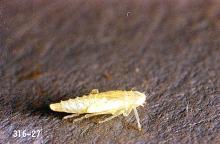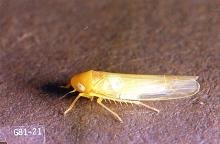Includes
Rose leafhopper (Edwardsiana rosae)
White apple leafhopper (Zonocyba (Typhlocyba) pomaria)
Pest description and crop damage The most common leafhopper pest in the PNW is the white apple leafhopper, although a very similar-appearing insect, the rose leafhopper, is also present. Other leafhopper species are found throughout the Pacific Northwest. Adults are about 0.125 inch in length, white to yellow in color, with wings held tent-like over the body. Wingless nymphs are light green and may move rapidly if disturbed. Adults and nymphs suck juices from leaves, causing stippling and mottling on leaves. Damage usually is most noticeable on poorly cared-for trees. In general, this pest is a minor problem, and even high populations rarely cause yield loss. The flying adults may become a nuisance pest during fruit harvest.
Biology and life history The insect overwinters as eggs just beneath the bark on 1 to 5 year-old twigs in the trees. The presence of the eggs is indicated by characteristic oblong, crescent-shape swellings in the bark. Eggs hatch at about the tight cluster stage (late March to mid-April), and nymphs feed for several weeks. Adults are flying by late May until frost when they are killed by the cold. Overwintering eggs are laid in September. There are two generations per year.
Pest monitoring As a minor pest, monitoring is not necessary, although the presence of the adults can be confirmed by limb taps in early morning.
Management-biological control
Parasitic wasps provide some control over leafhopper populations.
Management-chemical control: HOME USE
- azadirachtin (neem extract)-Some formulations are OMRI-listed for organic use.
- carbaryl-Highly toxic to bees.
- gamma-cyhalothrin-Highly toxic to bees.
- horticultural mineral oil-Some formulations OMRI-listed for organic use.
- imidacloprid-Highly toxic to bees. Soil drenches may have residual activity in woody plants lasting for 12 or more months. If short-term management is the goal, consider other approaches.
- insecticidal soap-May require several applications. Some formulations are OMRI-listed for organic use.
- kaolin-Applied as a spray to leaves, stems, and fruit, it acts as a repellant to some insect pests. Some formulations are OMRI-listed for organic use.
- lambda-cyhalothrin-Highly toxic to bees.
- plant-derived essential oils-Some have shown efficacy against leafhoppers. Some formulations are OMRI-listed for organic use.
- pyrethrins (often as a mix with other ingredients)-Highly toxic to bees. Some formulations are OMRI-listed for organic use.
- zeta-cypermethrin-Highly toxic to bees.
Management-chemical control: COMMERCIAL USE
Spring and summer spray
- carbaryl (Carbaryl 4L) at 2 to 3 quarts/A. REI 12 hr. PHI 3 days. Extremely toxic to aquatic invertebrates; avoid spray drift and runoff to surface waters.
- esfenvalerate (Asana XL) at 5 to 12 fl oz/A. REI 12 hr. PHI 14 days. Extremely toxic to fish and aquatic invertebrates; avoid spray drift and runoff to surface waters.
- thiamethoxam/chlorantraniliprole (Voliam Flexi) at 4 to 7 oz/A. Do not exceed 14 oz/A of Voliam Flexi per season. REI 12 hr. PHI 14 days.



